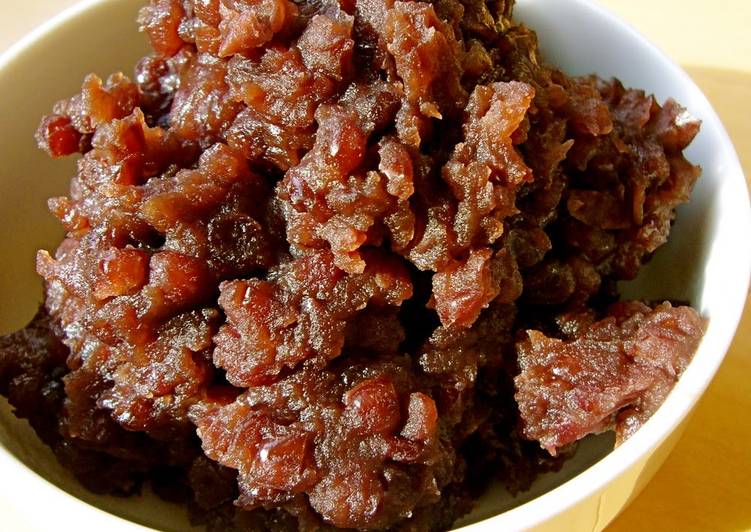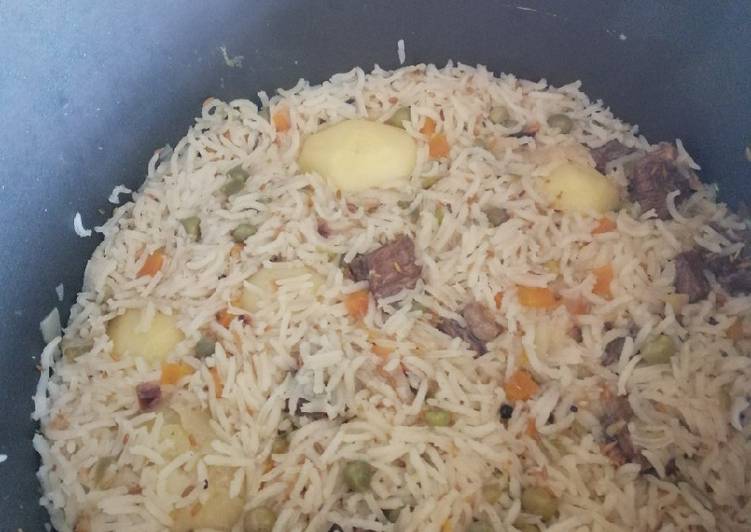
Hello everybody, it is me again, Dan, welcome to our recipe page. Today, I’m gonna show you how to prepare a special dish, homemade chunky red bed paste for ohagi and mochi. One of my favorites. For mine, I am going to make it a little bit tasty. This is gonna smell and look delicious.
Ohagi Recipe - Homemade Mochi Rice with Sweet Red Bean Paste. Red Bean Paste (Anko) - both recipes for Chunky (Tsubuan) and Fine (Koshian). White Bean Paste (Shiroan) - made of lima beans (butter beans).
Homemade Chunky Red Bed Paste for Ohagi and Mochi is one of the most well liked of current trending foods on earth. It’s easy, it’s fast, it tastes yummy. It is enjoyed by millions every day. Homemade Chunky Red Bed Paste for Ohagi and Mochi is something which I have loved my entire life. They are nice and they look wonderful.
To get started with this particular recipe, we must first prepare a few ingredients. You can have homemade chunky red bed paste for ohagi and mochi using 3 ingredients and 19 steps. Here is how you cook that.
The ingredients needed to make Homemade Chunky Red Bed Paste for Ohagi and Mochi:
- Prepare 300 grams Adzuki beans
- Take 300 grams Sugar
- Take 1/4 tsp Salt
Return the egg whites to the refrigerator to keep it cold. Tip: I froze my red bean paste balls for a bit to make the wrapping easier but I think you may not even need to do that. Homemade Sweet Red Bean Paste (Dou Sha). Learn how to make smooth and shiny sweet red bean paste (dou sha) or known as Anko in Japan that you can use as filling for many thanks for this, I am making mochi, with red bean paste and i was disappointed that it was a bit runny. this helped a lot.
Instructions to make Homemade Chunky Red Bed Paste for Ohagi and Mochi:
- Rinse the adzuki beans and soak in a pot with 3 cups of water. Bring to a boil over high heat, and then turn the heat down to medium. Simmer the beans for about 10 minutes.
- The beans will wrinkle gradually, and a brown scum will form on the surface.
- Add 2 cups of water to reduce the temperature of the cooking liquid.
- If you need to simmer the beans further, do over low heat. When the beans are plump without wrinkles and the cooking liquid is richly colored, turn off the heat.
- Drain the beans in a strainer. Gently stir the beans with your fingers while rinsing under running water. You want to rinse all the astringent cooking liquid away from the beans.
- Return the beans to the pot and add 3 cups of fresh water. Heat on high.
- When the beans have reached a boil, reduce the heat to low. In order to keep the beans from moving around, add an aluminum foil drop lid that is slightly larger than the mouth of the pot (press this down on the beans with the edges sticking up and it is easy to grab). Simmer for about 1 hour.
- The beans are finished when they easily pop when pressed between a pair of chopsticks, or between your fingers. Continue boiling until the liquid has reduced by half.
- Remove the drop lid, and add about 60 g (1/5 amount) of sugar to the surface, sprinkling it on with a wooden spatula. Replace the drop lid, and simmer without stirring for about 5 minutes.
- When the sugar has dissolved, repeat Step 9 twice. On the third time, increase the amount of sugar to about 90 g (1/2 recipe amount).
- After the sugar dissolves, add the remaining sugar and salt. Cover with the drop lid and continue to simmer the beans.
- When the beans have boiled down and achieved a glossy finish, remove the drop lid. Stir the beans with a wooden spatula, and continue to cook the beans as you further reduce the cooking liquid.
- When you can scrape the spatula across the bottom of the pot and you see the bottom, the anko is done.
- You can freeze the anko to store it. Divide into small portions, cover in plastic wrap, and store in a Ziplock bag. To use, defrost on a countertop or under running water.
- If you like the sweeter variety, use 250 g of adzuki beans, and increase the sugar to 350 g.
- For homemade ohagi, use the paste in.
- For homemade dorayaki, use this with - - https://cookpad.com/us/recipes/146495-dorayaki-with-pancake-mix-anko-and-butter
- How about as a crepe filling? - - https://cookpad.com/us/recipes/146478-easy-crepes-with-pancake-mix-in-a-frying-pan
- Try with chilled mizu-yokan? - - https://cookpad.com/us/recipes/146483-mizu-yokan-sweetened-and-jellied-bean-paste
Ohagi and Botamochi are very popular because of their rich, sweet taste. Chunky red bean paste tastes sweeter even though it contains the same amount of sugar. Split the red bean paste into thirds. Spread one part on a plastic wrap and place a mochi ball on top. Ohagi is mochi rice enclosed in anko, a sweet bean paste made of adzuki beans.
So that’s going to wrap this up for this exceptional food homemade chunky red bed paste for ohagi and mochi recipe. Thank you very much for your time. I’m confident that you can make this at home. There is gonna be interesting food in home recipes coming up. Don’t forget to bookmark this page on your browser, and share it to your family, friends and colleague. Thanks again for reading. Go on get cooking!


